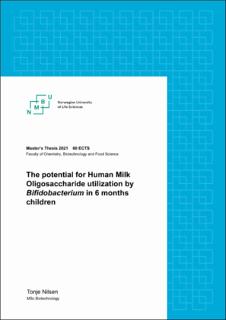| dc.contributor.advisor | Rudi, Knut | |
| dc.contributor.advisor | Nilsen, Morten | |
| dc.contributor.author | Nilsen, Tonje | |
| dc.date.accessioned | 2021-12-13T09:14:28Z | |
| dc.date.available | 2021-12-13T09:14:28Z | |
| dc.date.issued | 2021 | |
| dc.identifier.uri | https://hdl.handle.net/11250/2833923 | |
| dc.description.abstract | The infant gut microbiota is known to be dominated by Bifidobacterium, especially in healthy, breastfed infants. This is mainly due to their ability to utilize human milk oligosaccharides (HMOs) that are non-digestible glycans, unique to breast milk. From this utilization, metabolites such as short chain fatty acids (SCFAs) are produced, that have an important role in nurturing the epithelial cells in the large intestine. There is currently a knowledge gap related to how Bifidobacterium utilize HMOs in the infant gut. The aim of this thesis was therefore to analyze how Bifidobacterium degrade HMOs in the infant gut using a metagenomic and proteomic approach.
Potential HMO degradation by Bifidobacterium was studied using fecal samples from the PreventADALL study. To obtain an overview of the gut microbiota composition, and to select samples with high abundance of Bifidobacterium for further analyzes, a 16S rRNA sequencing was performed. The detailed composition and functional potential of Bifidobacterium species was found through a shotgun sequencing. To identify HMO utilizing proteins found in Bifidobacterium, a proteome analysis was performed, and the proteins were divided into different HMO degradation pathways. Several proteins related to HMO degradation were found either from both the shotgun and proteome data, or only from the shotgun data. For three out of five building blocks of HMO, whole degradation pathways were found. In addition to this, all the main enzymes to break down HMO; β-galactosidase, fucosidase, sialidase, GLNBP and β-hexosaminidase, were identified from the data.
In conclusion, Bifidobacterium has the ability to degrade HMO compounds, and there is a high potential that some Bifidobacterium species contain whole HMO degradation pathways. This provides a good base to research different HMO degradation pathways in specific Bifidobacterium species. | en_US |
| dc.description.abstract | Tarmmikrobiotaen til spedbarn er kjent for å være dominert av Bifidobacterium, spesielt hos friske, ammede spedbarn. Dette er hovedsakelig grunnet deres egenskaper til å utnytte spesifikke oligosakkarider (HMOer) i morsmelk, som er ikke-nedbrytbare glykaner. Fra denne nedbrytelsen blir det produsert metabolitter, slik som kortkjedede fettsyrer (SCFAer), som har en viktig rolle i å fungere som næring for epitelceller i tykktarmen. Det er for øyeblikket mangel på kunnskap relatert til hvordan Bifidobacterium bryter ned HMOer i tarmen til spedbarn. Målet med denne oppgaven var derfor å analysere hvordan Bifidobacterium bryter ned HMOer i tarmen til spedbarn ved å bruke en metagenomisk og proteomisk analyse. | en_US |
| dc.language.iso | eng | en_US |
| dc.publisher | Norwegian University of Life Sciences, Ås | en_US |
| dc.rights | Attribution-NonCommercial-NoDerivatives 4.0 Internasjonal | * |
| dc.rights.uri | http://creativecommons.org/licenses/by-nc-nd/4.0/deed.no | * |
| dc.title | The potential for human milk oligosaccharide utilization by Bifidobacterium in 6 months children | en_US |
| dc.type | Master thesis | en_US |
| dc.description.localcode | M-BIOTEK | en_US |

